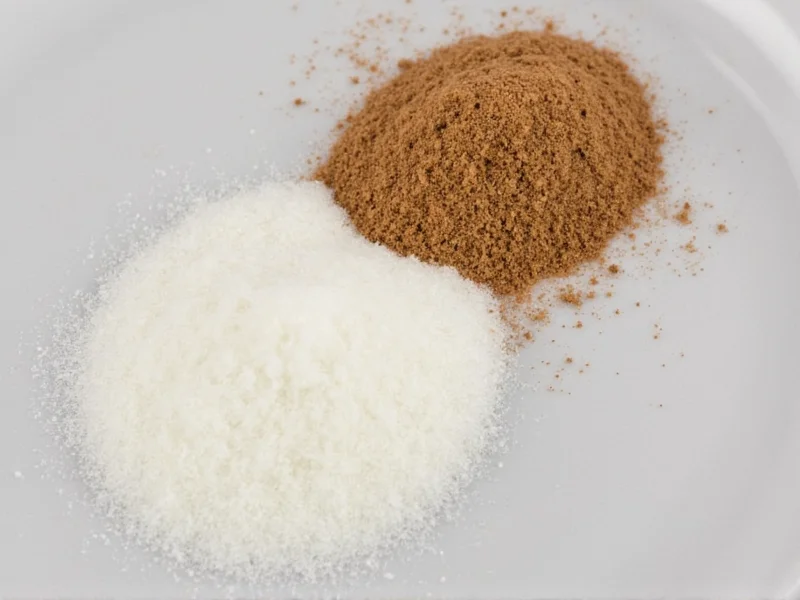When you're mid-recipe and realize you're out of onion powder, onion salt makes a practical substitute with proper adjustments. Understanding the composition and flavor profile differences between these pantry staples ensures your dishes maintain their intended taste balance without becoming overly salty.
Understanding the Composition Difference
Onion salt and onion powder serve different culinary purposes despite their similar base ingredient. Onion powder consists purely of dehydrated, ground onions, delivering concentrated onion flavor without additional seasoning. Onion salt, however, combines onion powder with table salt, typically in a 3:1 or 4:1 ratio (onion powder to salt).
| Ingredient | Composition | Flavor Profile | Best Uses |
|---|---|---|---|
| Onion Powder | 100% dehydrated onions | Pure onion flavor, slightly sweet | Recipes requiring precise salt control |
| Onion Salt | 75-80% onion powder, 20-25% salt | Onion flavor with pronounced saltiness | Dry rubs, seasoning blends, quick seasoning |
Proper Substitution Ratios and Techniques
Successfully substituting onion salt for onion powder requires careful measurement adjustments. For every 1 teaspoon of onion powder called for in a recipe:
- Use 3/4 teaspoon of onion salt
- Reduce additional salt in the recipe by 1/4 teaspoon
- Taste and adjust seasoning before finalizing
This substitution works best in recipes with multiple ingredients where the flavor can blend thoroughly. In delicate dishes or recipes where precise salt control matters significantly, consider alternative substitutes like fresh minced onion (use 1 tablespoon fresh for 1/4 teaspoon powder) or shallot powder.
Flavor Impact and Recipe Considerations
The substitution affects both flavor balance and texture. Onion salt dissolves more readily than pure onion powder, making it suitable for liquid-based recipes like soups and sauces. However, in dry rubs or spice blends, the salt content in onion salt can cause premature moisture absorption.
When substituting in baking recipes, exercise extra caution as salt affects yeast activity and gluten development. For baked goods requiring onion powder, consider using a smaller amount of onion salt (1/2 teaspoon per teaspoon of powder) and omit all additional salt to prevent texture issues.
Common Substitution Mistakes to Avoid
Cooks often make these errors when substituting onion salt for onion powder:
- Using equal amounts without salt adjustment (results in oversalted dishes)
- Substituting in recipes already high in sodium
- Using in delicate dishes like custards or meringues
- Not accounting for regional variations in commercial onion salt blends
Commercial onion salt products vary in their exact ratios. Some premium brands use a 4:1 ratio while budget options may contain up to 50% salt. Check your specific product's ingredient list for the most accurate substitution.
Storage and Shelf Life Considerations
Both ingredients maintain quality for 1-2 years when stored properly in airtight containers away from heat and moisture. However, onion salt's salt content makes it slightly more hygroscopic (moisture-attracting) than pure onion powder. In humid environments, onion salt may clump more readily.
Revive clumped onion salt by spreading it on a baking sheet and heating at 200°F for 10-15 minutes, then breaking up clumps and storing in a dry container with a silica packet. This process won't work for pure onion powder, which burns easily at higher temperatures.
When Not to Substitute
Avoid substituting onion salt for onion powder in these situations:
- Recipes specifically designed for low-sodium diets
- Dishes where salt content is precisely calibrated (like cheese-making)
- Recipes already containing multiple salted ingredients (bacon, soy sauce, capers)
- When making homemade spice blends for future use
In these cases, consider alternatives like fresh onion (use 1 tablespoon minced fresh onion per 1/4 teaspoon powder, adjusting liquid content) or shallot powder, which provides similar flavor without added salt.
Can I use onion salt instead of onion powder in meatloaf?
Yes, but use 3/4 teaspoon onion salt per teaspoon of onion powder called for and reduce additional salt by 1/4 teaspoon. Meatloaf contains other salty ingredients like Worcestershire sauce, so this adjustment prevents oversalting.
How does onion salt affect baking compared to onion powder?
Onion salt can impact baking by introducing additional salt that affects yeast activity and gluten development. For baked goods, use only half the amount of onion salt compared to onion powder and omit all additional salt to maintain proper texture and rise.
Does onion salt have the same shelf life as onion powder?
Onion salt typically has a slightly shorter shelf life than pure onion powder (12-18 months vs 18-24 months) because the salt content attracts moisture more readily. Store both in airtight containers away from heat and humidity for maximum longevity.
What's the best way to substitute onion salt in a low-sodium recipe?
For low-sodium recipes, avoid direct substitution. Instead, use fresh minced onion (1 tablespoon per 1/4 teaspoon powder) and add a small amount of onion powder if available. You'll need to adjust liquid content slightly as fresh onion adds moisture to the recipe.
Can I make my own onion salt from onion powder?
Yes, combine 3 parts onion powder with 1 part fine salt in a small bowl. Mix thoroughly and store in an airtight container. This homemade version lets you control the salt quality and avoid anti-caking agents found in commercial products.











 浙公网安备
33010002000092号
浙公网安备
33010002000092号 浙B2-20120091-4
浙B2-20120091-4